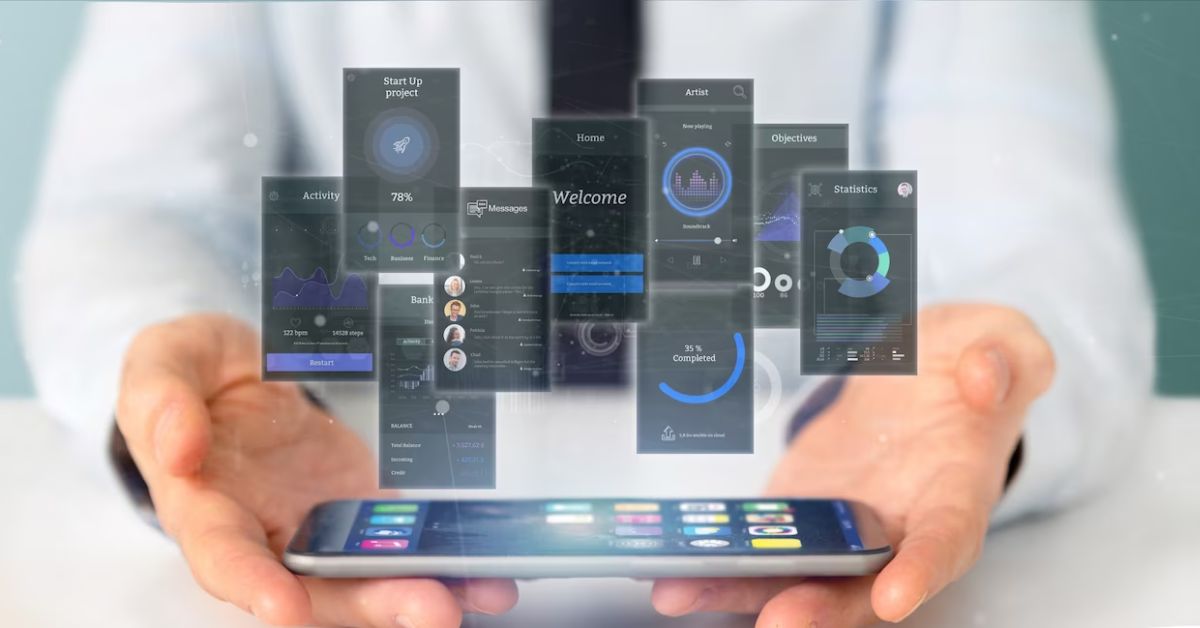Mobile App Development Trends: Enhancing User Experience in Technology

4 min read | By Postpublisher P | 28 December 2023 |
In today’s fast-paced digital era, mobile apps are essential in various aspects of our daily lives, transforming how we engage with technology from socialising to banking. Smooth, engaging, and user-friendly applications are crucial, even in the face of intense competition and millions of available apps. To create apps that stand out in the crowded app market and provide excellent user experiences, developers must prioritise best practices, particularly as smartphones become increasingly ingrained in our daily lives. The most recent advancements in mobile app development are examined in this article along with how they directly improve user experiences.
What is User Experience?

Fundamentally, user experience (UX) includes all factors that affect how users interact with and view a product. The physical, sensory, meaningful, passionate, and valuable aspects of human-machine interaction and product usage are called user experience (UX) in mobile app development. The following helps illustrate the key elements of an engaging user experience design.
𝐔𝐬𝐚𝐛𝐥𝐞: A mobile app needs to be effortless to use. It needs to be designed in such a way that is straightforward and intuitive to the user.
𝐏𝐫𝐚𝐜𝐭𝐢𝐜𝐚𝐥: No matter what, an app must fulfil a user’s need. If the product doesn’t fill a gap in the user’s life, they will not use it.
𝐃𝐞𝐬𝐢𝐫𝐚𝐛𝐥𝐞: A mobile app’s user interface (UI) design must be aesthetically pleasing. Visual design components play a significant role in positive emotional attribution.
𝐅𝐢𝐧𝐝𝐚𝐛𝐥𝐞: If a user finds a deficiency in the software, a solution should be immediately apparent.
𝐀𝐜𝐜𝐞𝐬𝐬𝐢𝐛𝐥𝐞: App design needs to accommodate every user.
𝐂𝐫𝐞𝐝𝐢𝐛𝐥𝐞: The company behind the mobile app has to be reliable.
The combination of these six components is what creates value for the user. The priority of any mobile app is to deliver a UX that maximises user value.
Top Current Trends

𝟏. 𝐀𝐝𝐚𝐩𝐭𝐚𝐛𝐥𝐞 𝐃𝐞𝐬𝐢𝐠𝐧 𝐮𝐬𝐢𝐧𝐠 𝐑𝐞𝐬𝐩𝐨𝐧𝐬𝐢𝐯𝐞 𝐃𝐞𝐬𝐢𝐠𝐧
Developing mobile apps nowadays would be impossible without responsive design, ensuring that apps adjust fluidly to different screen sizes and resolutions. With so many devices—from tablets and smartphones to smart TVs—developers concentrate on making apps that provide a unified and aesthetically pleasing user experience across many platforms. Adaptable grids and layouts make for the best possible viewing experience on every device, which enhances user satisfaction.
𝟐. 𝐈𝐧𝐭𝐞𝐠𝐫𝐚𝐭𝐢𝐨𝐧 𝐨𝐟 𝐀𝐑 𝐚𝐧𝐝 𝐕𝐑 𝐟𝐨𝐫 𝐈𝐦𝐦𝐞𝐫𝐬𝐢𝐯𝐞 𝐄𝐱𝐩𝐞𝐫𝐢𝐞𝐧𝐜𝐞𝐬
Virtual reality (VR) and augmented reality (AR) may now be incorporated into various sectors outside of gaming and entertainment through mobile applications. People’s interactions with digital information are changing due to technologies like AR and VR. Immersion travel experiences and virtual furniture arrangement in home décor apps are examples. This breakthrough makes enhancing user experiences and creating new opportunities for training, education, and mobile app visualization possible.
𝟑. 𝐅𝐨𝐜𝐮𝐬 𝐨𝐧 𝐒𝐩𝐞𝐞𝐝 𝐚𝐧𝐝 𝐏𝐞𝐫𝐟𝐨𝐫𝐦𝐚𝐧𝐜𝐞 𝐎𝐩𝐭𝐢𝐦𝐢𝐳𝐚𝐭𝐢𝐨𝐧
Speed and performance improvement are critical when users want quick gratification. Apps that load slowly and respond slowly may irritate and drive away users. Developers prioritise practical coding approaches, caching, and lazy loading to ensure fast app performance. Prioritizing speed improves user satisfaction and retention while also improving user experience.
𝟒. 𝐑𝐢𝐬𝐞 𝐨𝐟 𝐕𝐨𝐢𝐜𝐞-𝐀𝐜𝐭𝐢𝐯𝐚𝐭𝐞𝐝 𝐀𝐩𝐩𝐬 𝐚𝐧𝐝 𝐂𝐨𝐧𝐯𝐞𝐫𝐬𝐚𝐭𝐢𝐨𝐧𝐚𝐥 𝐈𝐧𝐭𝐞𝐫𝐟𝐚𝐜𝐞𝐬
Natural language processing (NLP) advances and speech recognition technology drive the popularity of voice-activated apps and conversational interfaces. Voice commands are now available for users to engage with apps, which makes tasks more comfortable and hands-free. Giving consumers a more intuitive and user-friendly experience; this trend is especially noticeable in virtual assistants, language learning applications, and navigation systems.
𝟓. 𝐏𝐞𝐫𝐬𝐨𝐧𝐚𝐥𝐢𝐳𝐚𝐭𝐢𝐨𝐧 𝐚𝐧𝐝 𝐀𝐈-𝐃𝐫𝐢𝐯𝐞𝐧 𝐔𝐬𝐞𝐫 𝐄𝐱𝐩𝐞𝐫𝐢𝐞𝐧𝐜𝐞𝐬
Customizing app interfaces according to user preferences is no longer the only purpose of personalization. Mobile apps that integrate artificial intelligence (AI) can provide highly tailored experiences by continuously evaluating user behaviour and making necessary adjustments. AI-driven personalization improves user engagement and happiness by predicting user actions and making suggestions for personalized content, all of which combine to provide a more immersive and customized experience.
𝟔. 𝐈𝐧𝐭𝐞𝐫𝐧𝐞𝐭 𝐨𝐟 𝐓𝐡𝐢𝐧𝐠𝐬-𝐏𝐨𝐰𝐞𝐫𝐞𝐝 𝐌𝐨𝐛𝐢𝐥𝐞 𝐀𝐩𝐩𝐬
An ecosystem of networked devices that can communicate and share data via the Internet is known as the Internet of Things (IoT).
Mobile apps with IoT capabilities provide an interface for users to manage and keep an eye on these gadgets. For example, smart home apps let customers control the lighting, security, and temperature of their homes from a distance. Wearable tech and health and fitness apps can work together to track various health data. Manufacturing process management and remote monitoring are made possible by industrial IoT apps.
As the number of IoT devices increases, mobile applications will be crucial for making use of the Internet of Things (IoT) and for encouraging simplicity, effectiveness, and creativity across a range of industries.
𝟕. 𝐂𝐥𝐨𝐮𝐝-𝐃𝐫𝐢𝐯𝐞𝐧 𝐌𝐨𝐛𝐢𝐥𝐞 𝐀𝐩𝐩𝐬
Mobile apps that are cloud-driven store data on servers in the cloud rather than on the device. There are several advantages to this strategy:
▪ Data consistency is ensured by enabling users to access data across many devices and from any location.
▪ Because server resources may be scaled up or down as needed, it makes scalability easy.
▪ It improves the performance of apps by shifting computationally demanding tasks to strong cloud servers.
▪ It makes it easier for programs that need several users to collaborate on shared data to function.
Cloud-driven mobile apps will rule the future thanks to developments in cloud technology and the increasing demand for seamless, scalable, and collaborative experiences.
Impact on User Experience

𝐄𝐧𝐡𝐚𝐧𝐜𝐞𝐝 𝐔𝐬𝐚𝐛𝐢𝐥𝐢𝐭𝐲 𝐚𝐧𝐝 𝐀𝐜𝐜𝐞𝐬𝐬𝐢𝐛𝐢𝐥𝐢𝐭𝐲 𝐨𝐟 𝐃𝐞𝐬𝐢𝐠𝐧
Current technology trends improve the usability and accessibility of mobile apps. While features like voice activation simplifies interactions and make apps user-friendly for a wide range of tech competency levels, responsive design guarantees accessibility across devices.
𝐈𝐦𝐩𝐫𝐨𝐯𝐞𝐝 𝐈𝐧𝐭𝐞𝐫𝐚𝐜𝐭𝐢𝐨𝐧 𝐰𝐢𝐭𝐡 𝐈𝐧𝐭𝐞𝐫𝐚𝐜𝐭𝐢𝐯𝐞 𝐂𝐨𝐦𝐩𝐨𝐧𝐞𝐧𝐭𝐬
User engagement significantly increases when AR, VR, and interactive features are integrated. Users are engrossed in these immersive experiences, which promote extended app interaction. Enhancing the user experience and building a strong bond between users and the app are features like gamification and real-time personalization.
𝐒𝐭𝐫𝐞𝐚𝐦𝐥𝐢𝐧𝐞𝐝 𝐍𝐚𝐯𝐢𝐠𝐚𝐭𝐢𝐨𝐧 𝐚𝐧𝐝 𝐅𝐚𝐬𝐭𝐞𝐫 𝐏𝐞𝐫𝐟𝐨𝐫𝐦𝐚𝐧𝐜𝐞
User satisfaction and navigation are directly impacted by speedy navigation and performance optimization. Navigating is made simple by apps that load and reply swiftly. The app’s responsive design and easy navigation make it easy for users to explore its capabilities, resulting in a happy and productive user experience.
Conclusion
All things considered, developments in mobile applications have a big influence on how people use technology. These developments enhance usability and accessibility, resulting in more productive and interesting interactions. Three essential components are AI-driven customization, AR and VR integration, and responsive design. Successful case studies highlight the benefits of embracing these trends despite obstacles including striking a balance between innovation and user experience and handling security concerns. In the ever-growing field of mobile application development, developers must stay abreast of shifting user expectations and evolving trends to stay competitive.
The latest from our editors
Join over 150,000+ subscribers who get our best digital insights, strategies and tips delivered straight to their inbox.


